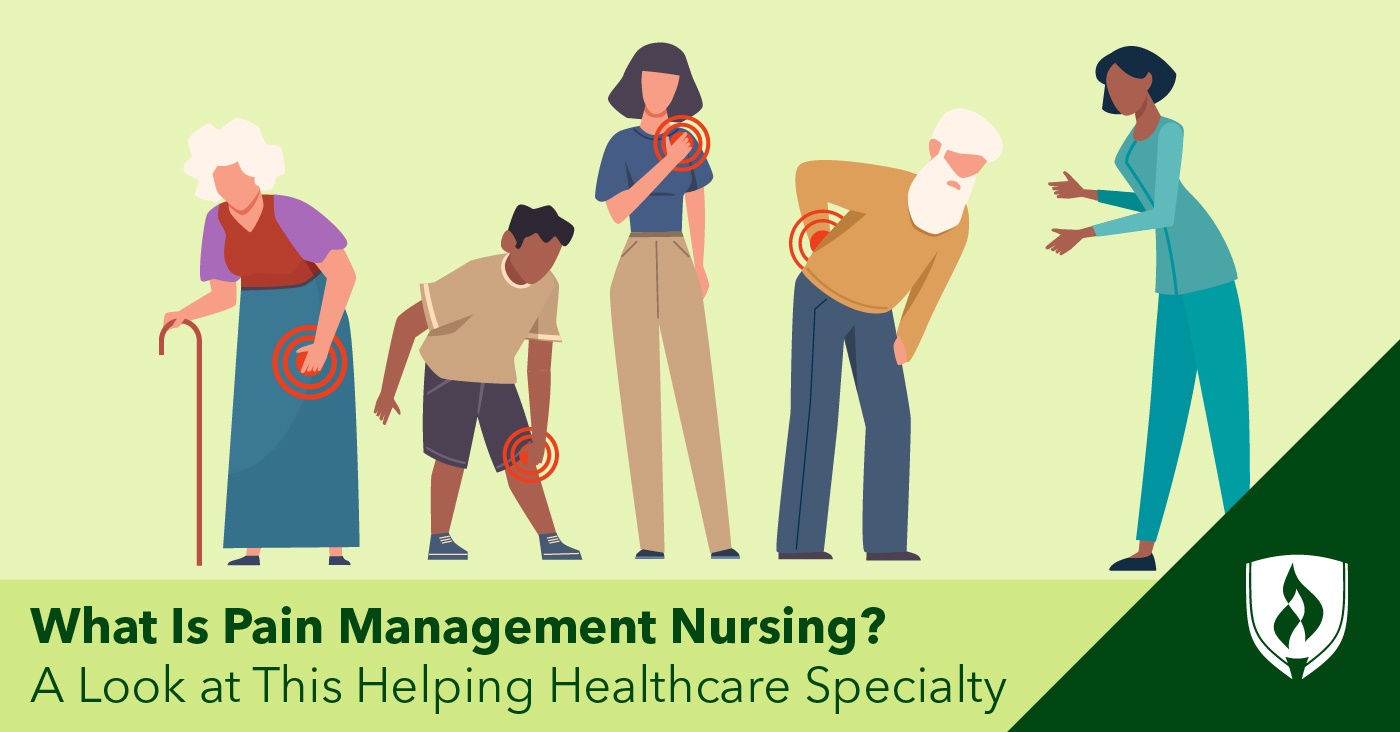What Is Pain Management Nursing? A Look at This Helping Healthcare Specialty
By Ashley Brooks on 05/24/2021

Can you imagine being in pain more often than not? It sounds like a nightmare, but for 50 million American adults, it’s reality.1 Chronic pain comes in many forms, from continuous to episodic or from targeted to widespread throughout the body. Those suffering from chronic pain share the need for pain management nurses to bring them relief.
Pain management nursing is a specialty that aims to improve patients’ quality of life so that they can continue doing activities they enjoy without pain holding them back. However, this isn’t an area of nursing many people know about. You probably have plenty of questions about what it’s really like to be a pain management nurse.
We spoke with Brandi Gregge, a family nurse practitioner with experience in pain management nursing, to learn more about this specialty. Join us as we explore the benefits, challenges and job duties of a pain management nurse—and, most importantly, discover the difference they can make for their patients.
Get Your Nursing School Questions Answered at a Nursing Information Session
The specialty of pain management nursing
Chronic pain can begin suddenly, like after an injury or accident, or increase gradually over time as in the case of certain illnesses or conditions, like arthritis or fibromyalgia. You can probably guess that this nursing specialty provides relief to patients who are experiencing these types of chronic pain. What you may not realize is that this entails much more than simply administering painkillers.
The American Society for Pain Management Nursing (ASPMN®) shares that “pain management should be delivered with an individualized, balanced approach—pain management is not one-size-fits-all.” This means that pain management nurses have the task of using different therapies to relieve their patients’ pain.
In addition to both narcotic and nonnarcotic medications, pain management nurses rely on therapies, like acupressure, heat, massage, guided imagery and distraction, to assist their patients in lowering pain levels. This all done with one goal in mind: “improving the patient's actual pain and functionality to perform activities of daily living,” Gregge says.
Pain management nursing: Job duties
All of these responsibilities add up to a variety of job duties that can be quite different from what nurses experience in other specialties. Of course, there are the usual tasks, like checking and monitoring a patient’s vital signs, but beyond that, pain management nurses perform tasks like these:
- Assessing and monitoring patients’ pain levels
- Working with doctors and others on a care team to create a treatment plan
- Administering medications or helping implement other therapies
- Educating patients and their families on pain relief options
- Monitoring patients and implementing safeguards to ensure that narcotic treatments do not become habit forming
This list may seem straightforward, but it becomes trickier when you remember that pain is subjective. Pain management nurses must be able to weigh a patient’s experienced pain levels, desired lifestyles and mental health alongside various therapy options.
“A lot of pain management is intuition and your evaluation of that patient,” Gregge says. “We are trained to look at how the patient experiences the illness and treat patients as a whole, which is what pain management requires.”
Pain management nurses are also more likely to work with an interdisciplinary team of specialists to provide patient care, such as physical therapists, acupuncturists, psychologists or addiction specialists.
Pain management nursing: Types of patients
Chronic pain is defined as pain that persists for more than 12 weeks, but for many patients, it lasts much longer. As a result, a pain management nurse is much more likely to see the same long-term patients over time than nurses working in other specialties.
Beyond that, there’s no limit to what type of patients a pain management nurse may see. “Pain hits all people in all walks of life,” Gregge says. Though she notes that some types of pain are more common, such as lower back problems due to an injury, pain management nurses could work with anyone from children to the elderly.
Some pain management nurses will see patients of certain demographics depending on their work environments. For example, those working in residential nursing facilities can expect to focus on elderly patients experiencing chronic pain, some of whom may be near the end of their lives or who are navigating other challenges, such as dementia.
Pain management nursing: Benefits and challenges
“The biggest positive is the closeness that develops with your patients because of the regular and long-term treatment plan,” Gregge says. While nurses in other specialties may see patients for just a few days—or even a few minutes—pain management nurses reap the reward of getting to know their patients over longer periods of time.
However, every specialty has its downsides. It can be hard to watch others suffer, even as you’re doing your best to help them. Patients in pain may react with anger or other strong emotions. Pain management nurses must be equipped with a strong dose of compassion and empathy to manage the emotional ups and downs of caring for patients with chronic pain.
Balancing narcotic medicines with other therapies can be another challenge. In an effort to slow the opioid epidemic, alternative therapies may be encouraged above habit-forming narcotic painkillers. Though Gregge says the majority of her patients are seeking care for the right reasons, there are some who are not.
Despite these challenges, pain management nurses can end each day knowing that they’re making a significant difference for their patients. Patients can experience a host of side effects from chronic pain, including depression, anxiety, insomnia, lack of appetite, nausea and increased stress—and nurses in this specialty have the satisfaction of knowing they’re reducing these symptoms and improving quality of life.
Pain management nursing: Education and training
The road to pain management nursing begins like any other nursing specialty: obtaining a nursing degree and passing the NCLEX-RN exam to become a registered nurse. Although some healthcare facilities will hire pain management registered nurses (RNs) with an Associate’s degree (ADN), others may prefer a Bachelor’s degree (BSN). Additionally, some employers with a focus on pain management may seek out nurse practitioners, which requires additional graduate-level education.
While pain management is a relatively niche focus area within nursing, there are options for earning a professional certification as well. Although certification isn’t typically required, it can show employers that you have a certain level of expertise in the pain management specialty. RNs with two years of nursing experience, 2,000 hours of related pain management work and 30 hours of continuing education credit are eligible to sit for the Pain Management Nursing Certification (PMGT-BC)™ exam through the American Nurses Credentialing Center.
As for gaining pain management experience, Gregge advises working in the hospital setting first, especially on a pain or palliative care team. “It's best to get related experience in the hospital first so you can understand the acute pain management.” After you’ve gained hospital experience, she believes you’ll be better prepared for outpatient pain management.
Is the pain management nursing specialty right for you?
Pain management nursing isn’t right for everyone. But the RNs who choose this career path can make a big difference in the lives of their patients.
If you’re still unsure about the right nursing specialty for you, take a look at the “Top 25 Types of Nurses Employers Are Looking to Hire” to get more ideas! No matter the specialized focus you choose to pursue as a registered nurse, the Rasmussen University Professional Nursing program can provide an excellent foundation for getting started.
1James Dahlhamer et al. “Prevalence of Chronic Pain and High-Impact Chronic Pain Among Adults—United States, 2016.” Morbidity and Mortality Weekly Report, Centers for Disease Control and Prevention, September 14, 2018 [accessed April 2021] www.cdc.gov/mmwr/volumes/67/wr/pdfs/mm6736a2-H.pdf
ASPMN is a registered trademark of American Society of Pain Management Nursing, Inc.




